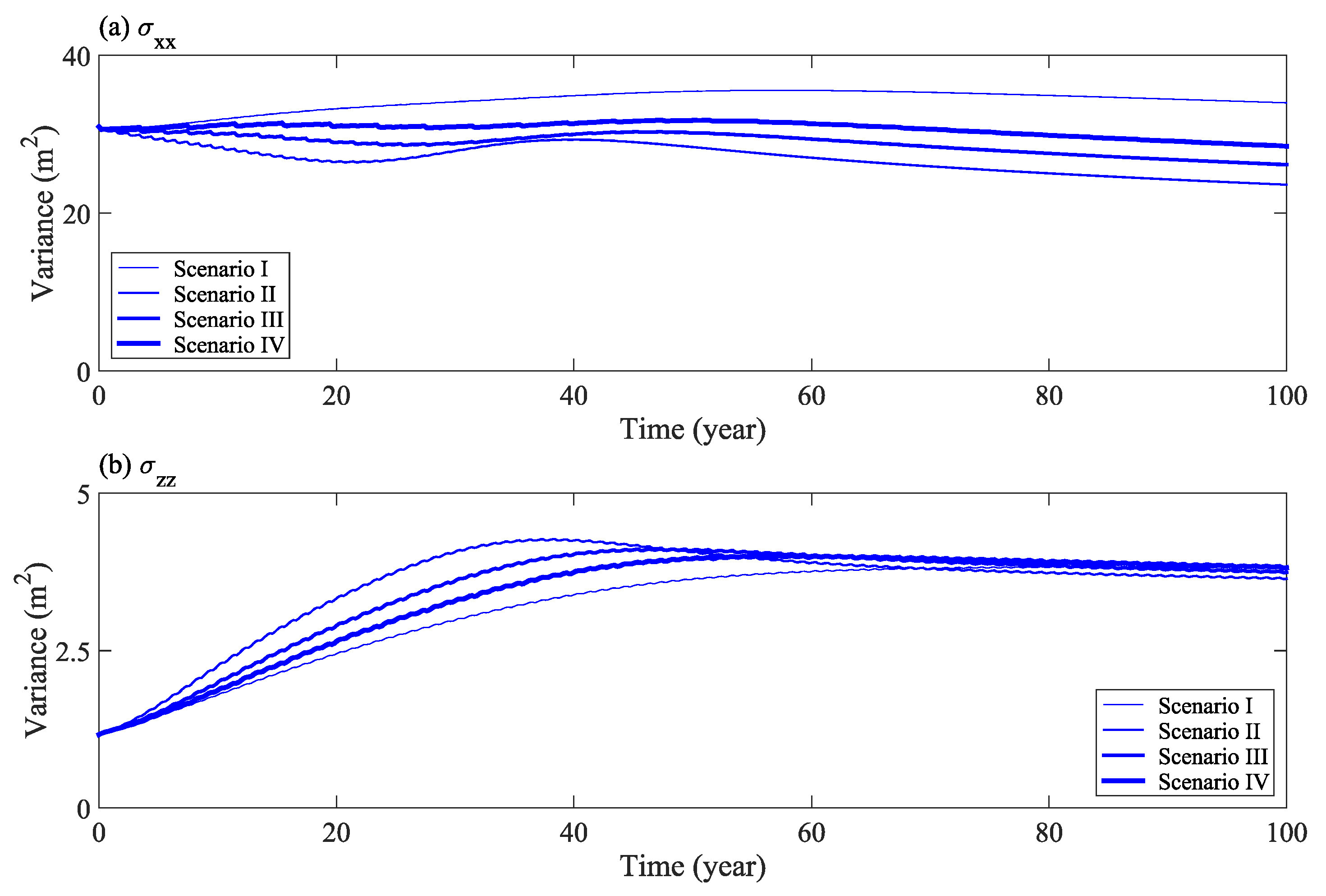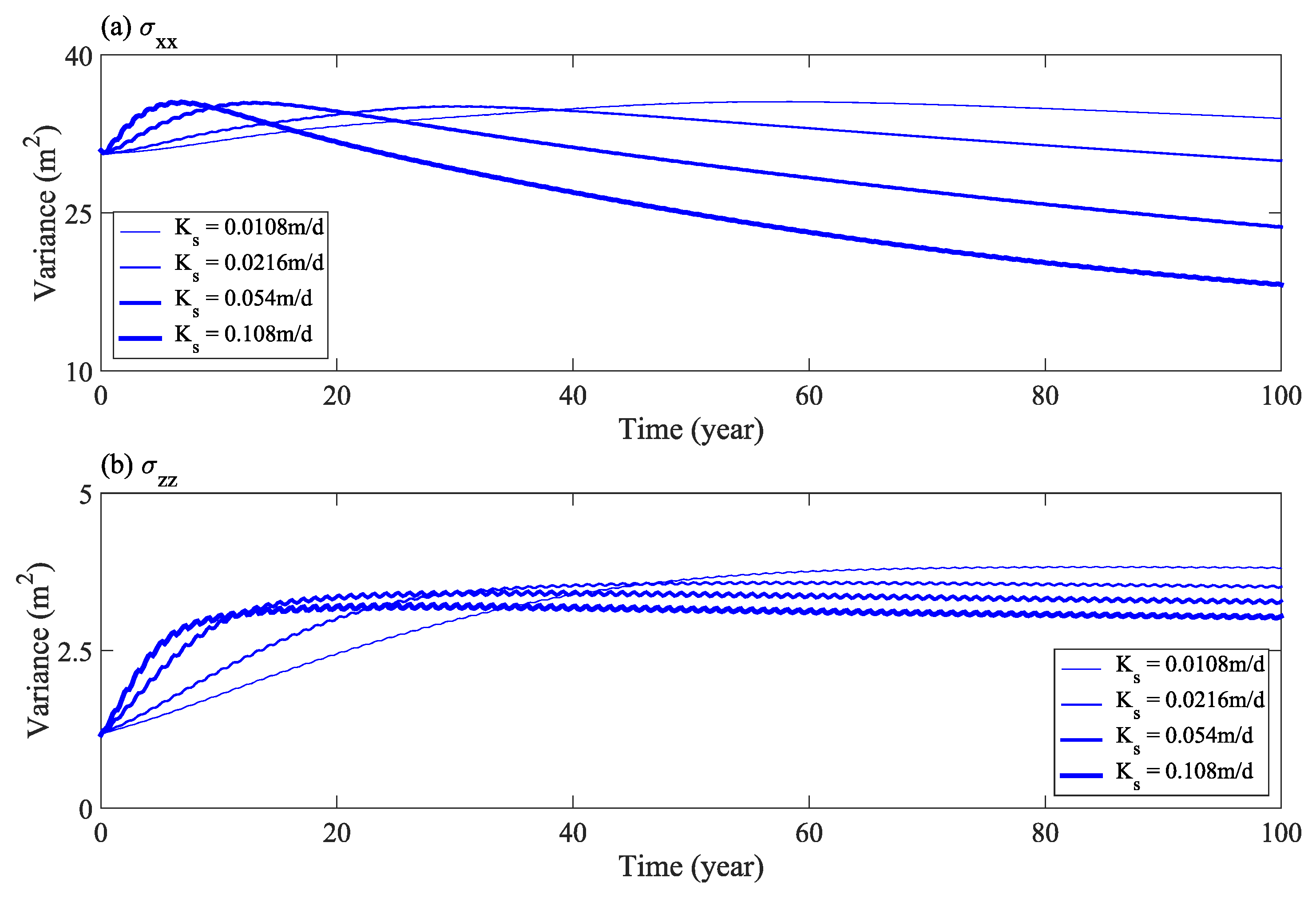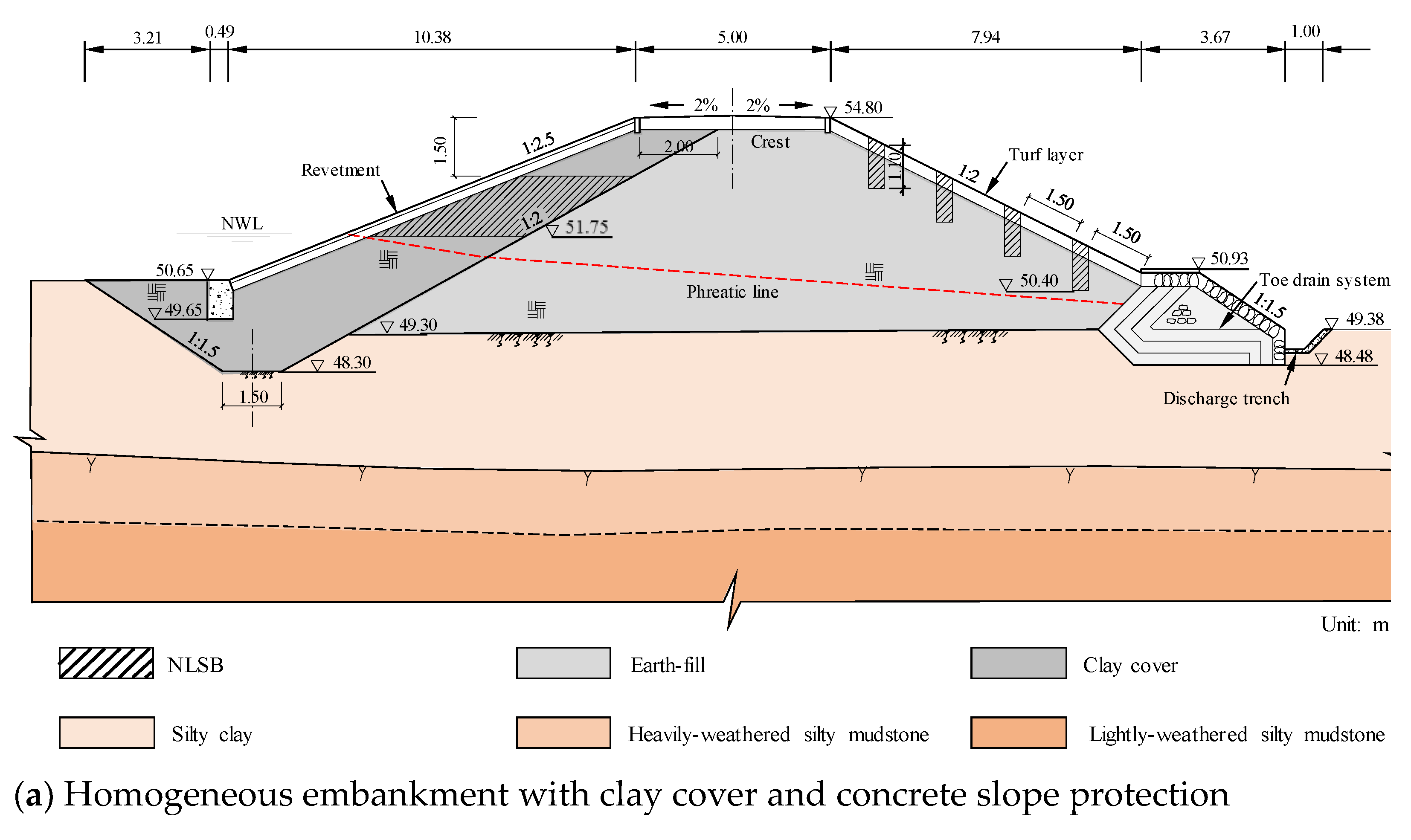A Simulation of Salt Transport in NaCl-Laden Soil Barrier to Control Subterranean Termites in an Earth Embankment
Abstract
1. Introduction
2. Materials and Methods
2.1. Structure of NaCl-Laden Soil Barrier (NLSB)
2.2. Numerical Methods
2.2.1. Governing Equations
2.2.2. Model Domain, Initial Hydraulic, and Boundary Conditions
2.2.3. Parameter Values
2.3. Moment Analysis
3. Results
3.1. Scenario Analysis with Respect to Different Water Levels
3.2. Influence of Saturated Hydraulic Conductivity
3.3. Scenario Analysis under Different Rainfall Infiltration Conditions
4. Discussion
5. Conclusions
Author Contributions
Funding
Institutional Review Board Statement
Informed Consent Statement
Data Availability Statement
Acknowledgments
Conflicts of Interest
References
- Martinez-Delclos, X.; Martinell, J. The oldest known record of social insects. J. Paleontol. 1995, 69, 594–599. [Google Scholar] [CrossRef]
- Krishna, K.; Grimaldi, D.A.; Krishna, V.; Engel, M. Treatise on the Isoptera of the world. Bull. Am. Mus. Nat. Hist. 2013, 377, 1–200. [Google Scholar] [CrossRef]
- Chouvenc, T.; Li, H.-F.; Su, N.-Y. Connecting termite researchers from around the world at ICE 2016. Am. Entomol. 2018, 64, 152–154. [Google Scholar] [CrossRef]
- Huang, F.-S.; Zhu, S.-M.; Ping, Z.-M.; He, X.-S.; Li, G.-X.; Gao, D.-R. Fauna Sinica, Insecta, Vol. 17, Isoptera; China Science Publishing: Beijing, China, 2000. [Google Scholar]
- Hu, Y.; Yu, B.-T.; Yin, X.-J.; Song, X.-G. Advance in the development of attractive lignocelluloses materials of termite in China. Chin. J. Hyg. Insect. Equip. 2018, 24, 396–399. [Google Scholar]
- Verma, M.; Sharma, S.; Prasad, R. Biological alternatives for termite control: A review. Int. Biodeterior. Biodegrad. 2009, 63, 959–972. [Google Scholar] [CrossRef]
- Kuswanto, E.; Ahmad, I.; Dungani, R. Threat of subterranean termites attack in the Asian countries and their control: A review. Asian J. Appl. Sci. 2015, 8, 227–239. [Google Scholar] [CrossRef]
- Evans, T.A.; Forschler, B.T.; Grace, J.K. Biology of invasive termites: A worldwide review. Annu. Rev. Entomol. 2013, 58, 455–474. [Google Scholar] [CrossRef]
- Bayoumi, A.; Meguid, M.A. Wildlife and safety of earthen structures: A review. J. Fail. Anal. Preven. 2011, 11, 295–319. [Google Scholar] [CrossRef]
- Henderson, G. The termite menace in New Orleans: Did they cause the floodwalls to tumble? Am. Entomol. 2008, 54, 156–162. [Google Scholar] [CrossRef][Green Version]
- Huang, Q.; Sun, P.; Zhou, X.; Lei, C. Characterization of head transcriptome and analysis of gene expression involved in caste differentiation and aggression in Odontotermes formosanus (Shiraki). PLoS ONE 2012, 7, e50383. [Google Scholar] [CrossRef] [PubMed][Green Version]
- Ghaly, A.; Adwards, S. Termite damage to buildings: Nature of attacks and preventive construction methods. Am. J. Eng. Appl. Sci. 2011, 4, 187–200. [Google Scholar] [CrossRef]
- Rust, M.K.; Su, N.Y. Managing social insects of urban importance. Annu. Rev. Entomol. 2012, 57, 355–375. [Google Scholar] [CrossRef] [PubMed]
- Su, N.-Y. Development of baits for population management of subterranean termites. Annu. Rev. Entomol. 2019, 64, 115–130. [Google Scholar] [CrossRef]
- Tian, W.-J.; Ke, Y.-L.; Zhuang, T.-Y.; Wang, C.-X.; Li, M.; Liu, R.-Q.; Mao, W.-G.; Zhang, S.-S.; Li, D. A review of the research on dike-infesting termites in China (Isoptera: Termitidae). Sociobiology 2008, 52, 751–760. [Google Scholar]
- Yang, X.; Henderson, G.; Mao, L.; Evans, A. Application of ground penetrating radar in detecting the hazards and risks of termites and ants in soil levees. Environ. Entomol. 2009, 38, 1241–1249. [Google Scholar] [CrossRef] [PubMed]
- Umaru, A.B.; Sangodoyin, A.Y.; Oke, I.A. On the causes and effects of earth dams failures in north-eastern Nigeria. Int. J. Eng. Res. Technol. 2014, 3, 2978–2985. [Google Scholar]
- Mo, J.; Yang, T.; Song, X.; Cheng, J. Cellulase activity in five species of important termites in China. Appl. Entomol. Zool. 2004, 39, 635–641. [Google Scholar] [CrossRef]
- Hu, J.; Zhong, J.-H.; Guo, M.-F. Foraging territories of the black-winged subterranean termite Odontotermes formosanus (Isoptera: Termitidae) in southern China. Sociobiology 2006, 48, 1–12. [Google Scholar]
- Tian, W.-J.; Ke, Y.-L.; Zhuang, T.-Y.; Wang, C.-X.; Li, M.; Liu, R.-Q.; Mao, W.-G.; Zhang, S.-S.; Li, D. Incipient colony development and biology of Odontotermes formosanus (Shiraki) and O. hainanensis (Light) (Isoptera: Termitidae). J. Agric. Urban. Entomol. 2009, 26, 147–156. [Google Scholar] [CrossRef]
- Li, D.; Tian, W.-J.; Li, M.; Chen, L.-L.; Meng, Q.-Z.; Mao, W.-G.; Li, Z.-P.; Huang, J.-P. Distinction between termite-induced piping in dikes and that caused by physical factors, and its treatment. Acta Entomol. Sin. 2004, 47, 645–651. [Google Scholar]
- Su, N.-Y. Novel technologies for subterranean termite control. Sociobiology 2002, 39, 1–7. [Google Scholar]
- Acda, M.N. Sustainable termite management using physical barriers. In Termites and Sustainable Management, Susttainability in Plant and Crop Protection; Khan, M.A., Ahmad, W., Eds.; Springer International Publishing AG: Cham, Switzerland, 2018. [Google Scholar]
- Acda, M.N.; Ong, H.B. Use of volcanic debris as physical barrier against the Philippine milk termite (Isoptera: Rhinotermitidae). Sociobiology 2005, 46, 117–130. [Google Scholar]
- Lewis, V.R.; Haverty, M.I.; Carver, D.S.; Fouche, C. Field comparison of sand or insecticide barriers for control of Reticulitermes spp. (Isoptera: Rhinotermitidae) infestation in homes in northern California. Sociobiology 1996, 28, 327–335. [Google Scholar]
- Evans, T.A.; Iqbal, N. Termite (order Blattodea, infraorder Isoptera) baiting 20 years after commercial release. Pest. Manag. Sci. 2015, 7, 897–906. [Google Scholar] [CrossRef]
- Su, N.-Y. A fluid bait for remedial control of subterranean termites. J. Econ. Entomol. 2015, 108, 274–276. [Google Scholar] [CrossRef]
- Verma, S.; Sharma, S.; Malik, A. Termiticidal and repellency efficacy of botanicals against Odontotermes obesus. Int. J. Res. Biosci. 2016, 5, 52–59. [Google Scholar]
- Su, N.-Y.; Scheffrahn, R.H. A review of subterranean termite control practices and prospects for integrated pest management programs. J. Integr. Pest. Manag. 1998, 3, 1–13. [Google Scholar] [CrossRef]
- Su, N.-Y. Technological needs for sustainable termite management. Sociobiology 2011, 58, 229–239. [Google Scholar]
- Chen, L.-H.; Pan, C.-H.; Chen, S.-M.; Song, X.-G.; Zheng, S.-Z.; Chen, S.-H. New technology of using salt to prevent termites for dikes and dams. Chin. J. Geotech. Eng. 2011, 33, 140–144. [Google Scholar]
- Fagbohunka, B.S.; Edorh, S.E.; Adeyanju, M.M.; Ezima, E.N.; Alabi, M.A.; Ogunlabi, O.O. Activities of a cellulase of the termite, Ametermes Eveuncifer (Silverstri) soldier: Clue to termites salt intolerance. J. Nat. Sci. Res. 2015, 5, 117–123. [Google Scholar]
- Maayiem, D.; Bernard, B.N.; Irunuoh, A.O. Indigenous knowledge of termite control: A case study of five farming communities in Gushegu District of Northern Ghana. J. Entomol. Nematol. 2012, 4, 58–64. [Google Scholar]
- Li, Y.; Dong, Z.-Y.; Pan, D.-Z.; Pan, C.-H. Effect of termite on soil pH and its application for termite control in Zhejiang Province, China. Sociobiology 2017, 64, 317–326. [Google Scholar] [CrossRef]
- Chen, L.-H. Cause and control of termite infestation at the northern seawall of Qiantang River. Zhejiang Hydrotech. 2002, 2, 34–35. [Google Scholar]
- Alkali, U.U.; Muktar, A. Effect of locally prepared compounds on the resistance of gum Arabic wood to termite attack. J. Environ. Iss. Agri. Devel. Count. 2011, 3, 128–132. [Google Scholar]
- Fagbohunka, B.S.; Ezima, E.N.; Adeyanju, M.M.; Alabi, M.A.; Oyedele, D.E.; Adeneye, A.A. Inhibition studies of some key enzymes of the termite Amitermes eveuncifer (Silverstri) workers: Clue to termites salt intolerance. Sci. Focus 2014, 19, 81–87. [Google Scholar]
- Fagbohunka, B.S.; Okonji, R.E.; Adenike, A.Z. Purification and characterization of cellulase from Termite Ametermes eveuncifer (Silverstri) soldiers. Int. J. Biol. 2017, 9, 1–9. [Google Scholar] [CrossRef][Green Version]
- Javaheri-Kermani, M.; Asoodeh, A. A novel beta-1,4 glucanase produced by symbiotic Bacillus sp. CF96 isolated from termite (Anacanthotermes). Int. J. Biol. Macromol. 2019, 131, 752–759. [Google Scholar] [CrossRef] [PubMed]
- Hu, Y.; Song, X.-G.; Chen, L.-H.; Ruan, G.-H.; Zhou, Y.-Q. Effect of saline soil in controlling termites. Chin. J. Vector Biol. Control 2014, 25, 148–151. [Google Scholar]
- Silva, J.A.K.; Simunek, J.; McCray, J.E. A modified HYDRUS model for simulating PFAS transport in the vadose zone. Water 2020, 12, 2758. [Google Scholar] [CrossRef]
- Dominguez-Nino, J.M.; Arbat, G.; Raij-Homan, I.; Kisekka, I.; Girona, J.; Casadesus, J. Parameterization of soil hydraulic parameters for HYDRUS-3D simulation of soil water dynamics in a drip-irrigated orchard. Water 2020, 12, 1858. [Google Scholar] [CrossRef]
- Ghazouani, H.; Rallo, G.; Mguidiche, A.; Latrech, B.; Douh, B.; Boujelben, A.; Provenzano, G. Assessing Hydrus-2D model to investigate the effects of different on-farm irrigation strategies on potato crop under subsurface drip irrigation. Water 2019, 11, 540. [Google Scholar] [CrossRef]
- Chen, S.; Shen, S.; Chen, L.; Lu, G. Test of engineering properties of impervious soil with salt. Adv. Sci. Technol. Water Resour. 2015, 35, 66–70. [Google Scholar]
- Li, Y.; Dong, Z.-Y.; Pan, D.-Z.; Pan, C.-H. Effects of subterranean termite nest architectures on earth embankment seepage and stability. Paddy Water Environ. 2020, 18, 367–384. [Google Scholar] [CrossRef]
- Simunek, J.; van Genuchten, M.T.; Sejna, M. The HYDRUS Software Package for Simulating Two-and Three Dimensional Movement of Water, Heat, and Multiple Solutes in Variably-Saturated Porous Media, Technical Manual, Version 2.0; PC Progress: Prague, Czech Republic, 2012. [Google Scholar]
- Van Genuchten, M.T. A closed-form equation for predicting the hydraulic conductivity of unsaturated soils. Soil Sci. Soc. Am. J. 1980, 44, 892–898. [Google Scholar] [CrossRef]
- Bear, J. Dynamics of Fluid in Porous Media; Elsevier: New York, NY, USA, 1972. [Google Scholar]
- IUSS Working Group WRB. World Reference Base for Soil Resources 2014, International Soil Classification System for Naming Soils and Creating Legends for Soil Maps, Update 2015; World Soil Resources Reports No. 106; FAO: Rome, Italy, 2015. [Google Scholar]
- Rowe, R.K.; Badv, K. Advective-Diffusive contaminant migration in unsaturated sand and gravel. J. Geotech. Eng. 1996, 122, 965–975. [Google Scholar] [CrossRef]
- Gelhar, L.W. Stochastic Subsurface Hydrology; Prentice-Hall: Englewood Cliffs, NJ, USA, 1993. [Google Scholar]
- Schulze-Makuch, D. Longitudinal dispersivity data and implications for scaling behavior. Ground Water 2005, 43, 443–456. [Google Scholar] [CrossRef] [PubMed]
- Singha, K.; Gorelick, S.M. Saline tracer visualized with three-dimensional electrical resistivity tomography: Field-scale spatial moment analysis. Water Resour. Res. 2005, 41, 1–17. [Google Scholar] [CrossRef]
- Ahn, T.; Desai, C.S. Stability of earth dam contaminated by chemical transport. Int. J. Numer. Anal. Meth. Geomech. 1999, 23, 1893–1908. [Google Scholar] [CrossRef]
- Gulsen, F.; Inui, T.; Kato, T.; Takai, A.; Katsumi, T. Numerical investigation on utilization of natural contaminated soil in the Embankments. In Proceedings of the 8th International Congress on Environmental Geotechnics, Hangzhou, China, 28 October–1 Noveber 2018; Volume 1, pp. 444–451. [Google Scholar]
- Ministry of Water Resources of China. Code for Design of Levee Project; (GB 50286-2013); China Planning Press: Beijing, China, 2013. [Google Scholar]
- Wang, D.X. Animal and plant communities and the protection of seawall in the south of the Yangtze River in the Qing dynasty. Collect. Essays Chin. Hist. Geogr. 2003, 18, 92–101. [Google Scholar]


















| Parameter | Soil Matrix |
|---|---|
| Residual water content, θr (m3m−3) | 0.02 |
| Saturated water content, θs (m3m−3) | 0.42 |
| Empirical parameter, α (m−1) | 0.3 |
| Empirical parameter, n | 1.3 |
| Empirical parameter, l | 0.5 |
| Saturated hydraulic conductivity, | |
| Ks0 (md−1) | 0.0108 |
| Ks1 (md−1) | 0.0216 |
| Ks2 (md−1) | 0.054 |
| Ks3 (md−1) | 0.108 |
Publisher’s Note: MDPI stays neutral with regard to jurisdictional claims in published maps and institutional affiliations. |
© 2021 by the authors. Licensee MDPI, Basel, Switzerland. This article is an open access article distributed under the terms and conditions of the Creative Commons Attribution (CC BY) license (https://creativecommons.org/licenses/by/4.0/).
Share and Cite
Li, Y.; Pan, D.-Z. A Simulation of Salt Transport in NaCl-Laden Soil Barrier to Control Subterranean Termites in an Earth Embankment. Water 2021, 13, 1204. https://doi.org/10.3390/w13091204
Li Y, Pan D-Z. A Simulation of Salt Transport in NaCl-Laden Soil Barrier to Control Subterranean Termites in an Earth Embankment. Water. 2021; 13(9):1204. https://doi.org/10.3390/w13091204
Chicago/Turabian StyleLi, Ying, and Dong-Zi Pan. 2021. "A Simulation of Salt Transport in NaCl-Laden Soil Barrier to Control Subterranean Termites in an Earth Embankment" Water 13, no. 9: 1204. https://doi.org/10.3390/w13091204
APA StyleLi, Y., & Pan, D.-Z. (2021). A Simulation of Salt Transport in NaCl-Laden Soil Barrier to Control Subterranean Termites in an Earth Embankment. Water, 13(9), 1204. https://doi.org/10.3390/w13091204






